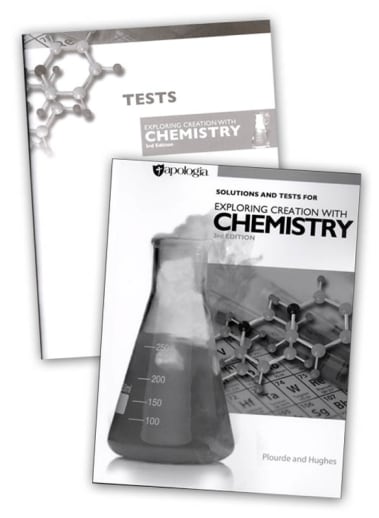Exploring Creation with Chemistry Solution Manual 3rd Ed. w/ Tests
Description
Solutions and test manual for Exploring Creation with Chemistry, 3rd Edition provides a rigorous foundation in chemistry in order to prepare your student for college-level studies. Topics include significant figures, units, classification, the mole concept, stoichiometry, thermochemistry, thermodynamics, kinetics, acids and bases, redox reactions, solutions, atomic structure, Lewis structures, molecular geometry, gas laws, and equilibrium.
The softcover solutions-and-tests manual contains answers to module review questions, practice problems, and extra practice problems, as well as the tests and test solutions. A booklet containing an extra set of tests is shrink-wrapped with the manual.
Apologia is a name you have long trusted for quality science curriculum, and this new edition of Exploring Creation with Chemistry makes chemistry approachable and doable in a homeschool setting. Now authored by Kristy Plourde, you will notice a few changes from previous editions.
The chapter order has been changed from the previous editions (1st and 2nd) of the curriculum. There are still 16 modules measurement, units, and the scientific method, atoms and molecules, atomic structure, molecular structure, polyatomic ions and molecular geometry, changes in matter and chemical reactions, describing chemical reactions, stoichiometry, acid-base chemistry, chemistry of solutions, gas phase, energy/heat and temperature, thermodynamics, kinetics, chemical equilibrium, and reduction-oxidation reactions. The front of the book offers a suggestion on how to use the book and the length of time typically spent to complete the course. "On Your Own" questions are found throughout the modules and are to be completed as the student reads the text answers are included at the end of the module. "Review Question" and "Practice Problems" are found at the end of each module to help students recall and apply important concepts presented in that module. The text is generous with examples, illustrations, and photos for clarity of concepts.
Some helpful resources are found at the back of the text glossary, tables/laws/equations, extra practice problems for each module, and a complete list of lab supplies.
Experiments are homeschool-friendly and can be completed using the lab kit (#008778) that is assembled by Natures Workshop and items that are easily accessible. If you want to do more advanced experiments, you can purchase the MicroChem Lab Kit (#020028). These experiments arent printed in the student text, but are mentioned and marked by a flask and test tube symbol along with where that experiment can be found in the MicroChem Manual. The experiments in this 3rd edition are a combination of some new ones and the tried-and-true from the previous editions. If you dont want or need to purchase the lab kit (#008778), the required items to complete experiments are a 1 mass scale (0 to 500 grams), blue and red litmus paper, 1 thermometer (-10 to 110 degrees C). If you have these three items, the text makes suggestions within the experiments for household substitutions of the other items needed.
A special website is available to accompany this course, offering web links and additional information for specific concepts. The web address is printed in the front of the text with instructions for access.
Quarterly tests and one test for each module are included in the test booklet and are perforated for easy removal. The test booklet can be purchased separately or with the solutions manual. The solutions manual includes answers to the review questions, practice problems, extra practice problems and all tests.
The Student Notebook is a handy companion to the course. It provides formatted pages on which to write the answers to the text questions On Your Own, Study Guide Questions, Practice Problems, and Extra Practice Problems. Experiment instructions are in the student notebook along with space for recording observations and data and making notes. There is also space for recording the optional MicroChem experiments. A suggested schedule will keep the student on track to finish the course. This notebook isnt included in the bundle, but is sold separately.
For economy purposes and ease of shopping, a bundle can be purchased that includes the textbook, tests, and solutions manual (CHM3ST). Algebra 1 is a prerequisite to doing this course and is important for solving and understanding chemical equations. If using Exploring Creation with Chemistry in a co-op setting, this new 3rd edition will not work with the older editions. Changes are significant enough that students will all need the same edition.
| Product Format: | Paperback |
|---|---|
| Grades: | 10-12 |
| Brand: | Apologia |
| Author: | Plourde and Hughes |
| ISBN: | 9781940110264 |
| Length in Inches: | 10.875 |
| Width in Inches: | 8.5 |
| Height in Inches: | 0.9375 |
| Weight in Pounds: | 2.4187 |

